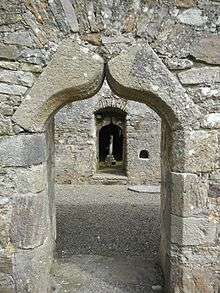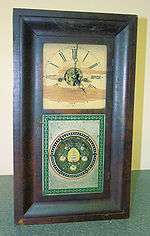Ogee


An ogee (/oʊˈdʒiː/ or /ˈoʊdʒiː/) is a curve (often used in moulding), shaped somewhat like an S, consisting of two arcs that curve in opposite senses, so that the ends are parallel. It is a kind of sigmoid curve.
The term has uses in architecture, mathematics, and fluid mechanics, as well as marine construction, clock design and plastic surgery.
Use in architecture
Ogee arch

In architecture, the principal use of the term is to describe an arch composed of two ogees, mirrored left-to-right and meeting at an apex.[1] Ogee arches were a feature of English Gothic architecture in the later thirteenth century.[2]
Moulding
A building's surface detailing (indoors or out) may have a moulding with an ogee-shaped profile, consisting (going from low to high) of a concave arc flowing into a convex arc, with vertical ends; if the lower curve is convex and higher one concave, this is known as a Roman ogee, although frequently the terms are used as if they are interchangeable and for a variety of other shapes. Alternative names for such a true Roman ogee moulding include cyma reversa and talon.[3]
The cyma reversa form occurs in antiquity. For example, in ancient Persia, the Tomb of Cyrus featured the cyma reversa.[4] The cyma reversa is also evident in ancient Greek architecture.[5] The ogee shape is one of the characteristics of the Gothic style of architecture, especially decorative elements in the 14th and 15th century late Gothic styles called Flamboyant in France and Decorated in England. Ogee windows and arches were introduced to European cities from the Middle East. The ogee curve is an analogue of a "cyma curve", the difference being that a cyma has horizontal rather than vertical ends.
The ogee and Roman ogee profiles are used in decorative moulding, often framed between mouldings with a square section. As such it is part of the standard classical decorative vocabulary, adopted from architrave and cornice mouldings of the Ionic order and Corinthian order. An ogee is also often used in the "crown moulding" frequently found at the top of a piece of case furniture, or for capping a baseboard or plinth, or where a wall meets the ceiling. An ogee moulding may be run in plaster or wood, or cut in stone or brickwork.
Other uses

Ogee is also a mathematical term, meaning an inflection point.
In fluid mechanics, the term is used for an ogee-shaped aerodynamic profile. For example, a wing may have ogee profile, particularly on supersonic aircraft such as the Concorde. Also, the downstream face of a dam spillway is usually formed in an ogee curve to minimize water pressure.
An "ogee washer" is a heavy washer with a large bearing surface used in marine timber construction to prevent bolt heads or nuts from sinking into the face of timbers. The term ogee is used due to the ogee shape in radial symmetry around the centre. Due to the size and shape, they are generally manufactured as a cast iron product in accordance with ASTM A47 or A48.
An "ogee clock" is a common kind of weight-driven 19th-century pendulum clock in a simplified Gothic taste, made in the United States for a mantelpiece or to sit upon a wall bracket. It is rectangular, with ogee-profile moulding that frames a central glass door that protects the clock face and the pendulum. The door usually carries a painted scene in the area beneath the face. Ogee clocks are one of the most commonly encountered varieties of American antique clocks.
In aesthetic facial surgery, the term is used to describe the malar or cheekbone prominence transitioning into the mid-cheek hollow. The aim of a mid-face rejuvenation is to restore the ogee curve and enhance the cheekbones. This enhancement is also commonly a part of a routine facelift.
In distillation, an ogee is the bubble-shaped chamber of a pot still that connects the swan neck to the pot. It allows distillate to expand, condense, and fall back into the pot.
See also
References and sources
- References
- ↑ Davies, Nikolas; Jokiniemi, Erkki (2011). Architect's Illustrated Pocket Dictionary. Oxford, England: Architectural Press. p. 318. ISBN 978-0-08-096537-6.
- ↑ Honour, H. and J. Fleming, (2009) A World History of Art. 7th edn. London: Laurence King Publishing, p. 391. ISBN 9781856695848
- ↑ Parker, John Henry (1850). A glossary of terms used in Grecian, Roman, Italian, and Gothic Architecture. 1. London: David Bogue. p. 159. OCLC 719426.
Cyma recta…which is hollow in the upper part, and round in the lower; and Cyma reversa, (Talon…) which is hollow in the lower part and round in the upper.
- ↑ C.Michael Hogan (2008) Tomb of Cyrus, The Megalithic Portal, ed. A.
- ↑ W.B.Dinsmoor, 1973
- Sources
| Wikimedia Commons has media related to Ogees. |
- William Bell Dinsmoor and William James Anderson (1973) The architecture of ancient Greece: an account of its historic development, Biblo & Tannen Publishers, 424 pages ISBN 0-8196-0283-3.
- C.Michael Hogan (2008) Tomb of Cyrus, The Megalithic Portal, ed. A.
- The Art of Distilling Whiskey, By Bill Owens And Alan Dikty, 2009. Page 26